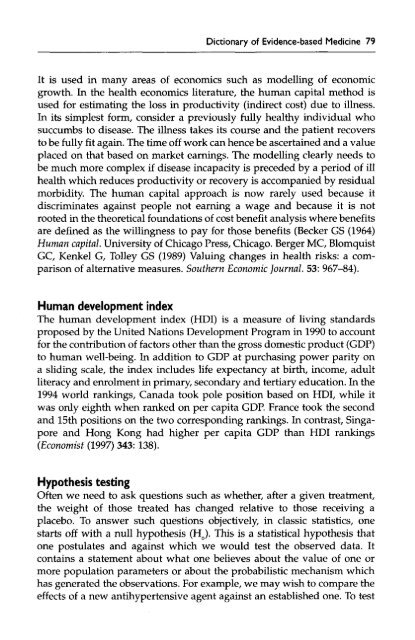Dictionary of Evidence-based Medicine.pdf
Dictionary of Evidence-based Medicine.pdf
Dictionary of Evidence-based Medicine.pdf
Create successful ePaper yourself
Turn your PDF publications into a flip-book with our unique Google optimized e-Paper software.
<strong>Dictionary</strong> <strong>of</strong> <strong>Evidence</strong>-<strong>based</strong> <strong>Medicine</strong> 79<br />
It is used in many areas <strong>of</strong> economics such as modelling <strong>of</strong> economic<br />
growth. In the health economics literature, the human capital method is<br />
used for estimating the loss in productivity (indirect cost) due to illness.<br />
In its simplest form, consider a previously fully healthy individual who<br />
succumbs to disease. The illness takes its course and the patient recovers<br />
to be fully fit again. The time <strong>of</strong>f work can hence be ascertained and a value<br />
placed on that <strong>based</strong> on market earnings. The modelling clearly needs to<br />
be much more complex if disease incapacity is preceded by a period <strong>of</strong> ill<br />
health which reduces productivity or recovery is accompanied by residual<br />
morbidity. The human capital approach is now rarely used because it<br />
discriminates against people not earning a wage and because it is not<br />
rooted in the theoretical foundations <strong>of</strong> cost benefit analysis where benefits<br />
are defined as the willingness to pay for those benefits (Becker GS (1964)<br />
Human capital University <strong>of</strong> Chicago Press, Chicago. Berger MC, Blomquist<br />
GC, Kenkel G, Tolley GS (1989) Valuing changes in health risks: a comparison<br />
<strong>of</strong> alternative measures. Southern Economic Journal. 53: 967-84).<br />
Human development index<br />
The human development index (HDI) is a measure <strong>of</strong> living standards<br />
proposed by the United Nations Development Program in 1990 to account<br />
for the contribution <strong>of</strong> factors other than the gross domestic product (GDP)<br />
to human well-being. In addition to GDP at purchasing power parity on<br />
a sliding scale, the index includes life expectancy at birth, income, adult<br />
literacy and enrolment in primary, secondary and tertiary education. In the<br />
1994 world rankings, Canada took pole position <strong>based</strong> on HDI, while it<br />
was only eighth when ranked on per capita GDP. France took the second<br />
and 15th positions on the two corresponding rankings. In contrast, Singapore<br />
and Hong Kong had higher per capita GDP than HDI rankings<br />
(Economist (1997) 343: 138).<br />
Hypothesis testing<br />
Often we need to ask questions such as whether, after a given treatment,<br />
the weight <strong>of</strong> those treated has changed relative to those receiving a<br />
placebo. To answer such questions objectively, in classic statistics, one<br />
starts <strong>of</strong>f with a null hypothesis (H o ). This is a statistical hypothesis that<br />
one postulates and against which we would test the observed data. It<br />
contains a statement about what one believes about the value <strong>of</strong> one or<br />
more population parameters or about the probabilistic mechanism which<br />
has generated the observations. For example, we may wish to compare the<br />
effects <strong>of</strong> a new antihypertensive agent against an established one. To test










